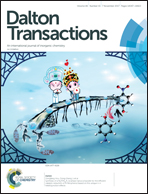Amidine functionalized phosphines: tuneable ligands for transition metals†
Abstract
Attachment of racemic 1,3,5,7-tetramethyl-2,4,6-trioxa-8-phosphatricyclo[3.3.1.13,7]decane (α,β-CgP) to (1R,5S)-1,8,8-trimethyl-2,4-diazabicyclo[3.2.1]oct-2-ene gave a diastereomeric mixture of a novel amidine–phosphine ligand, α,β-CgPAm. The phosphination was completely selective for the 4-position of the bicyclic amidine and there was no subsequent 1,2-migration of the α,β-CgP group. Methylation of the non-phosphinated nitrogen gave the amidinium salt [α,β-CgPAmMe]BF4 as a diastereomeric mixture. The donating ability of α,β-CgPAm and [α,β-CgPAmMe]+ has been assessed through the synthesis and characterization of appropriate Rh(I), Au(I) and Pt(II) complexes. As expected α,β-CgPAm is a better net donor than the cationic derivative as shown by the magnitude of the νCO stretches in the IR spectra of the [Rh(L)(CO)(acac)]0/+ complexes and through determination of the relative energies of the HOMO and LUMO orbitals for both ligands by DFT. Attempts to resolve [Au(α,β-CgPAmMe)Cl]BF4, [Pt(α,β-CgPAmMe)Cl3], [Rh(α,β-CgPAmMe)(acac)(CO)]BF4 and [Rh(α,β-CgPAmH)(acac)(CO)]BF4 by fractional crystallization were unsuccessful as diastereomeric mixtures were obtained in every case; the structures of the last three complexes have been determined by single-crystal X-ray techniques and compared with related literature complexes.



 Please wait while we load your content...
Please wait while we load your content...